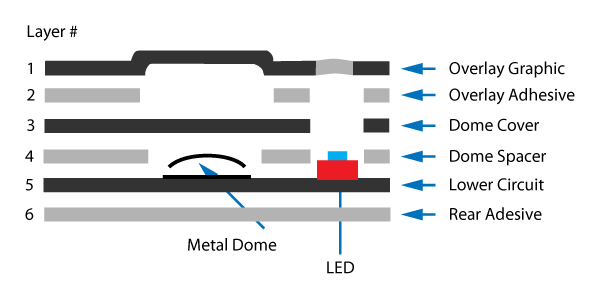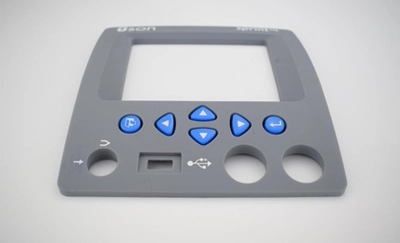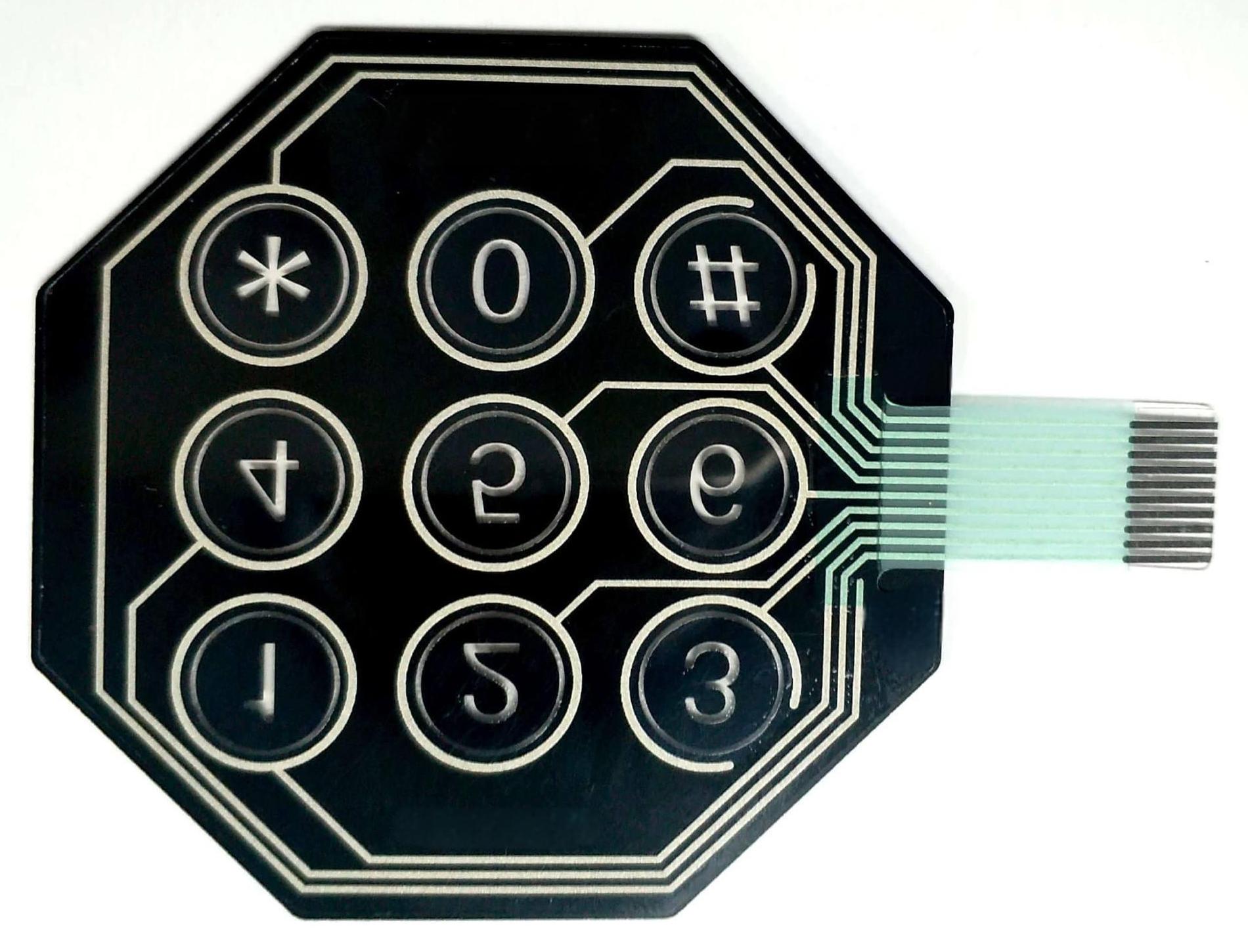How membrane switch is enhancing user interaction in medical devices
The Production Process Behind Membrane Layer Switch Over: What You Required to Know
The manufacturing procedure behind membrane switches over combines careful layout, product selection, and quality assurance. It starts with recognizing the intricacies of membrane layer switch design and advances with various phases, including material selections and printing methods. Each stage plays a crucial duty in making certain performance and durability. Nonetheless, the complexities of layer building and the rigorous testing criteria might expose understandings that are not instantly noticeable. What exists beyond these foundational aspects?
Understanding Membrane Layer Switch Over Design
Although membrane buttons might appear easy at first glimpse, their layout involves elaborate considerations that ensure capability and resilience. The layout procedure starts with a comprehensive understanding of individual demands, including the interface's designated application and ecological aspects. Comfort designs is a vital component, as the format has to facilitate simplicity of usage while making certain that responsive responses fulfills individual expectations.Moreover, the layering of elements, such as graphic overlays, sticky layers, and conductive traces, should be exactly engineered. membrane switch. This layered arrangement not just affects the button's responsiveness however likewise affects its longevity. Attention is offered to the securing strategies employed to safeguard against dampness and dirt, which might compromise efficiency. In addition, style factors to consider reach appearances, where color design and visual quality improve user experience. Inevitably, the layout of membrane layer switches equilibriums performance, user experience, and durability, making certain that they satisfy the needs of numerous applications effectively
Materials Used in Membrane Switch Over Production
When picking materials for membrane switch production, it is vital to ponder both performance and toughness. The main materials consist of polyester and polycarbonate films, which give flexibility and toughness. These movies are usually covered with sticky to ensure appropriate bonding to substrates. Conductive inks, typically composed of silver or carbon, are vital for producing electrical links within the button, permitting dependable operation.Additionally, a safety layer, such as a hard coat, is regularly related to enhance scrape resistance and durability. The option of backing material, such as acrylic or foam, can considerably influence the button's tactile feeling and total user experience. Numerous ecological factors, consisting of temperature level and moisture, ought to lead product choice to guarantee peak efficiency in particular applications. Eventually, the appropriate combination of products adds to the membrane layer button's performance and lifespan, making informed selections vital for producers.
The Printing Process: Creating Graphics and Text
The printing procedure in membrane layer button manufacturing plays a substantial function in generating high-quality graphics and text. Various visuals style methods are used to ensure visual allure and performance, while careful ink option techniques are essential for durability and performance. Recognizing these components is basic for accomplishing best results in membrane button style.
Graphic Design Techniques
Graphic design strategies play a vital duty in the printing process of membrane buttons, as they specify just how graphics and message will ultimately appear on the last product. Effective visuals layout involves the critical use typefaces, colors, and layouts to enhance readability and aesthetic appeal. Designers frequently utilize vector graphics for scalability, making certain that pictures remain sharp at various dimensions. Additionally, focus to comparison and placement is vital, as it affects individual interaction and visual top quality. The unification of branding aspects, such as logo designs, have to be managed with treatment to preserve brand name integrity. Generally, thoughtful visuals design strategies contribute significantly to the capability and beauty of membrane layer buttons, impacting individual experience and product performance.
Ink Option Methods
Selecting the proper ink is essential for accomplishing the wanted aesthetic quality and toughness in membrane layer switch production. Different ink kinds are made use of, consisting of solvent-based, water-based, and UV-curable inks. Each type provides unique features, such as adaptability, resistance, and adhesion to ecological aspects. Solvent-based inks are usually preferred for their durability and vibrant colors, while water-based inks are much more environmentally friendly however may have restrictions in bond. UV-curable inks offer fast curing and robust performance. Additionally, color matching techniques guarantee that the chosen inks line up with style specs. Ultimately, the choice of ink must consider factors such as application method, substratum compatibility, and end-use needs to accomplish exceptional lead to membrane button graphics and message.
Layer Building and Assembly

Product Selection Process
A careful choice of products is crucial in the production process of membrane switches, as it directly influences performance and longevity. The primary materials used include polyester, polycarbonate, and various conductive inks. Polyester is typically favored for its exceptional resistance to chemicals and abrasion, making it ideal for rough settings. Polycarbonate, on the various other hand, gives superior clarity and influence resistance, which is beneficial for applications requiring visibility and robustness. Conductive inks, generally composed of silver or carbon, are vital for creating dependable electrical paths. In addition, the selection of sticky materials impacts the overall honesty of the button - membrane switch. Examining aspects such as environmental exposure, responsive comments, and aesthetic requirements overviews suppliers in choosing the very best materials for their details applications
Layer Bond Techniques
Sticking layers in membrane layer switch construction is a vital procedure that ensures functionality and long life. Different adhesion strategies are utilized to secure excellent bonding in between layers, which usually consist of making use of adhesives, heat, and pressure. Pressure-sensitive adhesives (PSAs) are typically made use of for their simplicity of application and instant bonding capacities. Furthermore, thermal bonding strategies can be applied, where warmth is used to turn on sticky properties, securing a solid bond. The selection of adhesion approach greatly relies on the materials included and the specific application requirements of the membrane layer button. Correct alignment and consistent application of adhesives are important to stop issues, securing the switch operates successfully throughout its desired life expectancy.
Top Quality Control Steps
Ensuring quality assurance throughout the layer building and construction and setting up of membrane switches is crucial for maintaining efficiency and dependability. This procedure commonly involves several critical steps, consisting of thorough assessments at each phase of manufacturing. Manufacturers utilize sophisticated screening approaches, such as peel examinations and adhesion analyses, to validate the stability of layer bonds. Furthermore, aesthetic inspections are conducted to recognize any type of problems in printing or material inconsistencies. Environmental problems, such as temperature level and humidity, are very carefully monitored to ensure excellent healing and attachment. Moreover, regular calibration of equipment helps maintain precise manufacturing standards. By implementing these quality control measures, manufacturers can greatly minimize the danger of product failure, guaranteeing that the last membrane layer changes satisfy the required specifications and consumer assumptions.
Examining and Top Quality Control Procedures

Advancements in Membrane Change Technology
As advancements in modern technology remain to develop, membrane layer switches are benefiting from ingenious advancements that enhance their functionality and customer experience. One significant innovation is the integration of capacitive touch modern technology, which allows for even more instinctive and receptive user interfaces. This change not only boosts visual appeals however also minimizes mechanical deterioration, expanding the life-span of the switches.Additionally, advancements in graphic overlay materials have led to improved longevity and resistance to environmental variables such as dampness and UV light. These products currently use improved clearness and brightness, additional boosting the visual appeal.Furthermore, the consolidation of clever modern technology is changing membrane layer changes right into interactive control board, enabling connection with IoT devices. This connectivity promotes a seamless individual useful source experience, leading the way for applications in different sectors, from healthcare to customer electronic devices. Jointly, these technologies position membrane changes as vital components in contemporary tool style.
Frequently Asked Inquiries
How much time Does the Membrane Change Production Process Take?
The period of the membrane layer switch manufacturing process can vary substantially. Variables such as complexity, materials used, and production volume influence timelines, with normal manufacturing varying from a couple of days to numerous weeks for conclusion.
What Are the Common Applications for Membrane Switches?
Membrane layer buttons are commonly utilized in various industries, including auto controls, house appliances, medical tools, and customer electronic devices (membrane switch). Their versatility and resilience make them optimal for applications needing easy to use user interfaces and trustworthy performance in diverse settings
Can Membrane Layer Changes Be Custom-made for Details Demands?

What Is the Life-span of a Regular Membrane Change?
The life expectancy of a common membrane switch differs, however usually, it ranges from 1 to 5 million cycles. Elements such as use, setting, and material high quality significantly affect resilience and general efficiency with time.

Are Membrane Layer Switches Eco-friendly?
The ecological kindness of membrane switches varies. Some products used might not be recyclable, while others can be eco-friendly. The general influence depends on making practices and products, demanding careful factor to consider during option and disposal. The manufacturing procedure behind membrane switches over combines cautious style, material choice, and top quality control. It starts with understanding the complexities of membrane switch style and progresses through different phases, consisting of product options and printing anchor methods. When choosing materials for membrane button manufacturing, it is essential to ponder both efficiency and durability. A mindful selection of products is necessary in the production process of membrane layer buttons, as it directly affects capability and durability. The selection of attachment approach greatly depends on the materials entailed and the certain application requirements of the membrane button.